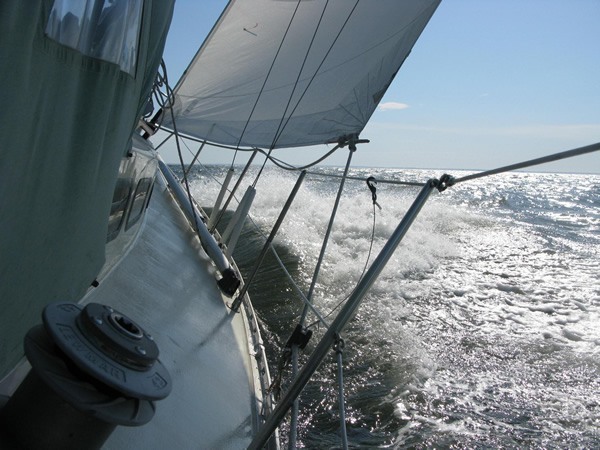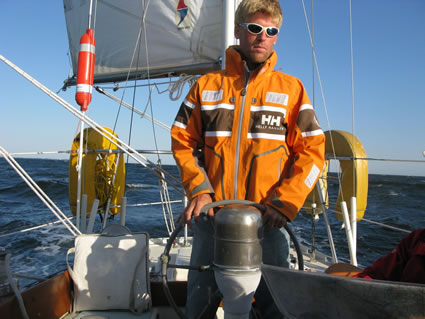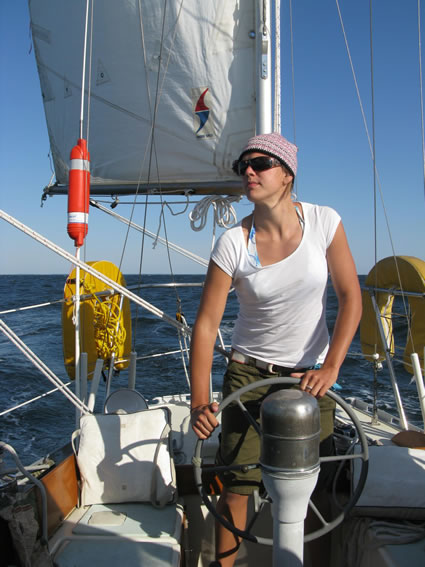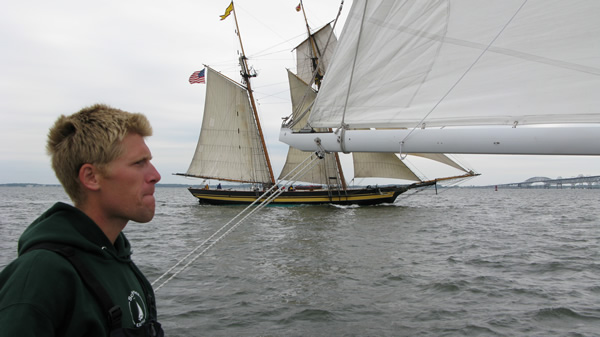Around the World by Sailboat
How to Find Life-Changing Work and Travel
Article and photos by Andy Schell
Resources updated 8/28/2023 by Transitions Abroad

|
|
Sailing fast and hard aboard the yawl Arcturus.
|
We were heaved to in the middle of the Atlantic, the sails of the 40-foot sloop set in such a way that the boat drifted slowly through the water, riding gently upon the heaving ocean swell that rose and fell with cosmic regularity. The puffy trade wind clouds marched across the sky in the perpetual easterly breeze. The sea itself was an indescribable shade of deep blue that exists only in deep waters far offshore, a color for which we have no word.
I was on the lee deck, wedged between the coach roof and the lifelines, bracing myself against the swell, gripping an old plastic sextant and practicing my sun sights. Engaging in a method of navigation used for centuries is to truly become one with the universe, a sensation long lost among the lives of those on shore. After plotting my line of position that I obtained by calculating the angle of the sun on the horizon, I figured we were around 26 degrees North latitude, 65 degrees West longitude, just about halfway between Charleston, SC, and our landfall in the Virgin Islands. We were seven days off the East Coast, another seven or so more to sail. We had finally adjusted to life at sea, the simple life of living in tune with the universe.
Traveling and Working as a Volunteer Crew Member

|
|
The author at the helm of the yawl Arcturus.
|
Amazingly, I was along for this trip of a lifetime as a volunteer crew member. The owner had paid my way, provided the food onboard, and would pay for a return ticket from Tortola upon our successful delivery of his yacht to the islands, where he planned to use it over the winter months. The 40-foot, French-built sloop boat was incredibly comfortable for the four of us onboard — my father, another 20-something young woman, and the volunteer French captain. We had a nicely-sized galley with working refrigeration, ample sleeping space, and plenty of food (and coffee) for two weeks at sea.
Traveling the world by sailboat is a dream shared by many but experienced by few — more often than not, thrown to the wind and destroyed by careers, commitments, and shore side attachments. But life is gratifying for those who commit to the sea — simple in its routines yet profoundly natural.
As a lifelong sailor and professional captain, I have traveled the world by every means imaginable, yet I have found that the best way to travel is under sail. For those looking for a unique way to see the world and experience life, becoming volunteer crew doing yacht deliveries is an exciting, unique, and reasonably affordable way to get around.

|
|
Mia Karlsson at the helm of the yawl Arcturus.
|
How to Find the Right Boat to Work On
Yacht deliveries can range from taking a neglected 32-footer built in the 1960s from Bermuda to Nova Scotia in the dead of winter (which I have unfortunately experienced) to sailing a sparkling new 70-footer in the warm Trade Winds of the Caribbean, island hopping your way around some of the most beautiful sailing grounds in the world. So it pays to do some research before signing up for any trip that is out there.
Walk to Docks to Find a Boat: Ironically, the best way to get a job as a delivery crew member is to arrive in a new port on a sailboat and walk the docks looking for work. Unfortunately, the age-old catch-22 situation rears its ugly head — you need experience to be crew, yet need to crew to gain experience. Suppose you are lucky enough to live in a sailing city — such as Annapolis, MD, Ft Lauderdale, FL, or any coastal town in the Caribbean or Mediterranean. In that case, walking the docks and talking to people is your best bet for finding a boat. The girl on my last trip found our boat precisely that way. She was a local from Charleston, SC, simply looking for sailing experience and a ride to the islands where she wanted to pursue her kite surfing passion. Since we were only three then, we welcomed her extra help, even though she had never been on a sailboat before.
Use the Internet: If you are like me, come from a rural inland town, or are otherwise far removed from the ocean, the Internet is helpful and provides another way to find a boat. Several websites are dedicated to finding crew, particularly for deliveries, and they often allow you free access. Professional delivery skippers often post ads looking for volunteer crew people, and it is usually just a matter of sending your resume, a photo, and a short email about why you want to crew that will get you on a boat. Frequently these skippers are willing to take inexperienced crew as a third or fourth member and are usually very amenable to teaching.
Take Part in “Cruising Rallies”: Increasing numbers of retired businessmen and women are buying boats with big dreams of crossing big oceans without the knowledge, skill, or confidence to do so alone. Several career sailors have recognized this problem, and "Cruising Rallies" are becoming increasingly popular in all the world's oceans. They are organized by experienced sailors with thousands of ocean miles, and together with up to 50 other boats, inexperienced sailors (primarily retirees) can cross the ocean of their dreams in the relative safety of the group with experienced leadership. Once in port, these newfound ocean sailors have the added benefit of organized parties and events to share the joys of their first ocean passage with others.
You can be a part of the increasing popularity of cruising rallies, and many of the organizations behind the logistics maintain websites and crew registers. The Carib 1500, for example, is perhaps the most popular cruising rally on this side of the Atlantic, with nearly 50 boats, all over 40 feet (and many much bigger), sailing non-stop from Norfolk, VA, to Tortola in the British Virgin Islands. The rally occurs after hurricane season and before the onset of winter, in early November. They also organize a return rally in May from Tortola to Bermuda. From there, the boats split up and headed east to Europe or back to the U.S.
What About Experience?

|
|
The author at the helm of the 74' Schooner Woodwind, Pride of Baltimore II in
the background.
|
Many captains, including myself, require at least one if not two, professional or very seasoned sailors to join them on a major ocean crossing. However, like me, many are more than willing to take a few extra inexperienced sailors or intrepid adventurers along for the ride and are often willing to instruct them along the way.
The key to finding a boat to sail on is to present yourself as a trustworthy person eager to join the trip. Ulterior motives are often very apparent, and no captain is willing to take along someone just looking for a free ride.
Working Aboard the Sailing Boat
The work aboard an ocean sailing boat is difficult, tiring, and unending. A passage of even ten days sounds short, yet when you're on a watch schedule of four hours on and eight hours off, one day seems like two, and you must adapt to an utterly different way of life than the one you are accustomed to ashore. Everyone shares in all the duties involved in running the boat, from standing watch in the rain at 2 a.m. to cooking breakfast and making coffee. Then you must clean up upon arrival when the boat is in shambles, and you have not had a freshwater shower in two weeks.
Life at sea is incredibly raw and incredibly basic. Your world shrinks to the three miles or so you can see in every direction before the horizon curves out of view. A passing freighter is often the most exciting thing on a given day. The intense discomfort of being salty and sticky for two weeks is offset by the rewards of a cloudless night watch under a new moon. The sky is so dark you can scarcely see your hand in front of your face, yet the stars fill the night sky like an enormous diamond exploding in the center of the universe, sending fragments to every corner of space. You will see more shooting stars on one night watch than you would in a lifetime ashore; at sea, the lights of civilization do not pollute the sky.
Ocean Sailing Makes the World Feel Big Again
In our age of instant communication and light-speed travel, crossing even a short distance in a sailboat reminds us that despite our attempts to shrink the world with technology, our planet remains one enormous place. After two weeks at sea, watching a distant island grow on the horizon provides an indescribable feeling of accomplishment. The first beer ashore never tasted better, and a freshwater shower after weeks of bathing in the salty ocean is a blessing from Heaven.
If you plan accordingly and have ample time, traveling the globe by "hitchhiking" on sailing yachts is a unique and rewarding way to see the world. After the first trip, you still gain experience, and finding and sailing on additional boats becomes progressively easier. You will save thousands on airfare and gain a greater appreciation for the distances we travel so quickly through the sky. But most importantly, you will return to nature, experience life with a stronger sense of connection to the universe, and return with unforgettable stories. You will change.
|
For More Info on Finding Work on Sailboats of All Kinds Around the World
Check out the list of websites below offering crewing opportunities around the world. The best ones require a paid membership, but the small fee is well worth the experience you will have once signed on a boat.
Crewseekers.net — Offers amateur and professional yacht crewing positions available worldwide. Registration and posting is free. To contact yacht owners and join their crew, you must become a member for a fee — a U.K.-based site.
Findacrew.net — Lists available crew positions, paid and unpaid, and boats available worldwide.
Workaway.info
—
A general site for work abroad, paid and unpaid, with a search option that pulls up many positions on yachts or other sailboats worldwide.
You will only receive pay for some trips as a professional sailor. However, owners will likely pick up the tab for airfare to and from the boat and almost always provide food en route.
Occasionally you will find a cruising couple looking for an extra hand or two to move their boat across a large ocean to their next port. These people will often require a small stipend for your onboard expenses (i.e., food) and will not cover airfare. However, this is usually the best and easiest way to cover large distances under sail, as you can sail from port to port on several different cruising yachts, often spending far less money than you would if you had been traveling by conventional means while staying in hotel or hostel-style accommodations.
When interviewing for a crew position, the most important attribute you can have is trustworthiness and an honest, hard-working attitude. Yacht owners, especially the big ones, desire reliable people, and once you gain their confidence will often provide further opportunities to sail with them.
|
Andy Schell is a professional captain and freelance writer who lives aboard his sailboat Arcturus in Annapolis, MD, and travels extensively.
|
